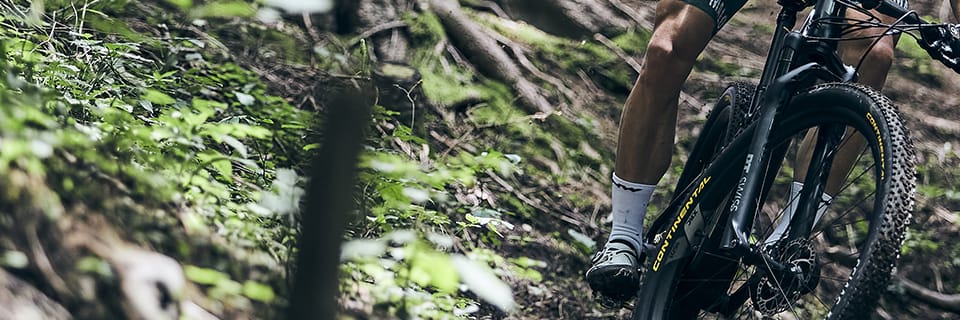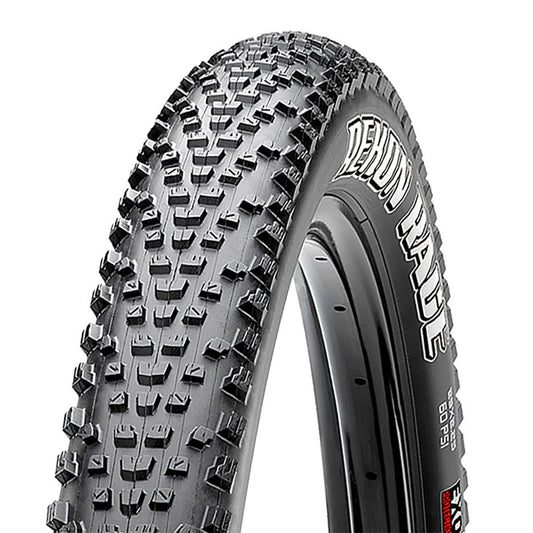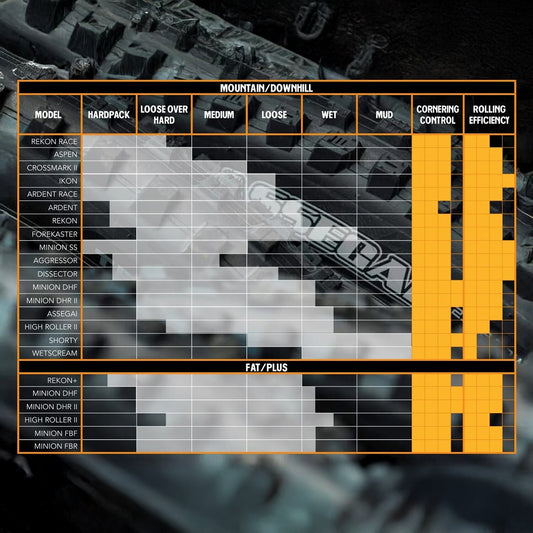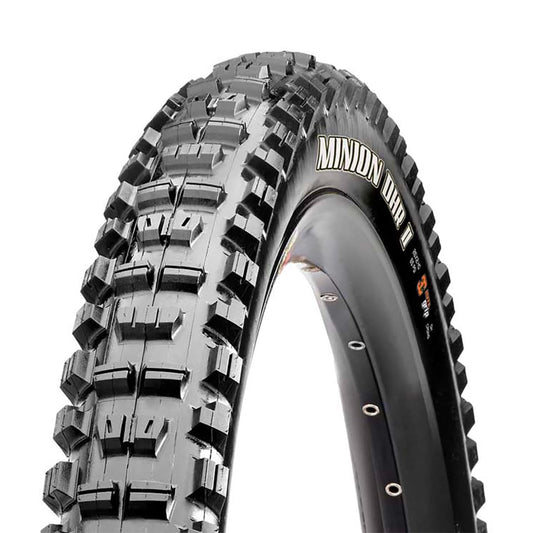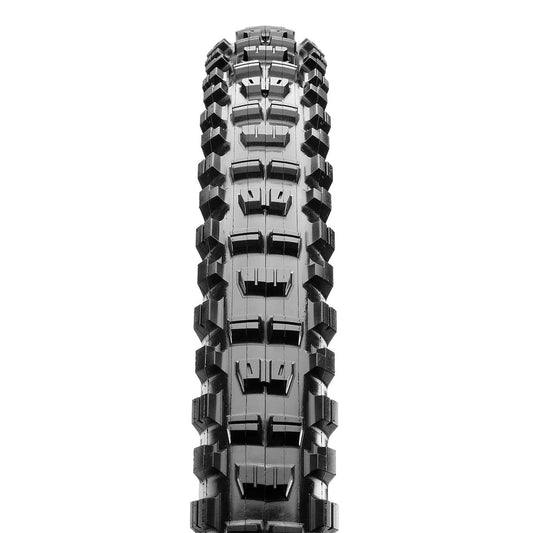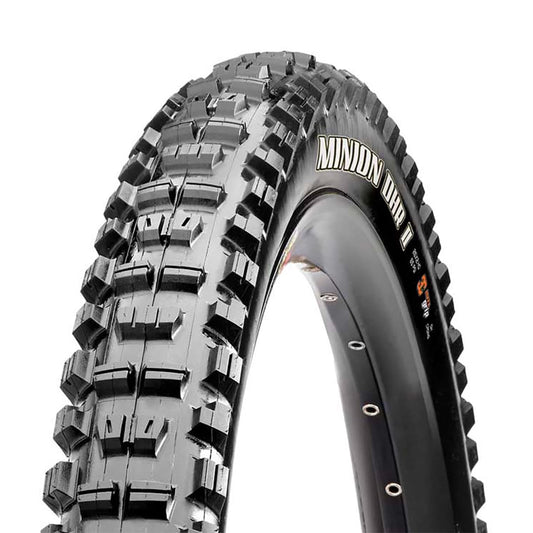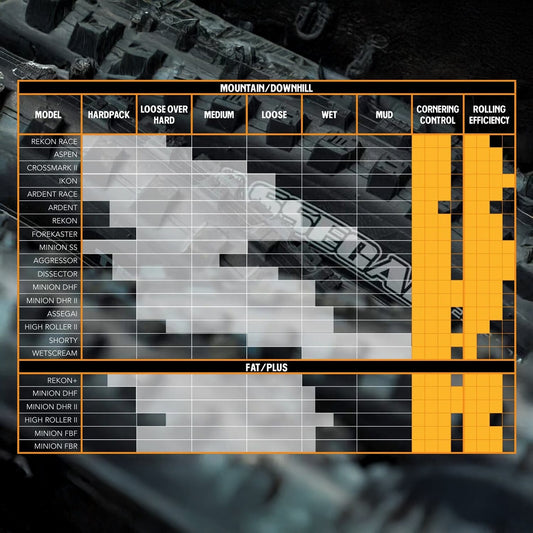It's worth remembering that your mountain-bike tires are the only link between your mountain bike and the terrain. Their role is to guarantee good grip for traction, but they must also ensure your bike's braking, steering, comfort and performance.
Standards
- Wheel size for an adult bike: 26" ; 27.5" MTB wheel 27.5+; 29+ and 29" MTB wheel
- Mounting options to suit your needs MTB wheels :
- Tubetype (*)Tubetype: a tire designed to be mounted with an inner tube.
- Tubeless Ready : designates a tire that can be mounted without an inner tube, provided a preventive is used. Do not confuse with a Tubeless* tire.
- Tubeless : designates a tire designed to be mounted tubeless with or without a preventive. Not to be confused with a Tubeless Ready* tire.
- Maximum tire width allowed by your frame and/or fork
- Tire beads: flexible or rigid
Tire components
Apart from the technologies and options specific to each brand, there are a number of common features:
The frame is made up of a braid of nylon cords. The number of cords on a given surface is expressed in TPI. The higher the value, the softer, more comfortable and generally lighter the tire. The average value is between 60 and 100 TPI.
The bead wires are the two hoops embedded in the tire's bead that hold it firmly to the rim. They can be rigid (in steel or Kevlar) for a basic tire or a tire that puts the rim to the test (Trials or DH / Freeride); or flexible (usually in polyamide) for a more comfortable, high-performance, lightweight tire.
The hardness of the rubbermeasured in Shore A, plays an important role. The softer it is (between 40a and 50a), the better the tire's grip. On the other hand, the harder the rubber (between 60a and 80a), the more rolling and robust the tire. Some tires combine rubber of different hardnesses on the central tread and sidewalls to optimize handling.
Types of mounting
Tubetype or tube-type
This remains the most classic type of mounting.
Tubeless Ready
Can be mounted tubeless, as long as you use a puncture-prevention agent, since this tire is not waterproof.
Tubeless
Designed to be mounted without an inner tube (even if it can accommodate one) and without puncture-prevention fluid.
The advantages of tubeless mounting are many: you can ride at lower pressures for greater grip and comfort, fewer pinch flats and a reduced risk of punctures with the addition of preventive fluid, and significant weight savings in the case of Tubeless Ready mounting.
Tire width and ETRTO standard
The same tire model can come in several widths for a given wheel diameter. In simple terms, the thinner the tire, the better the performance, to the detriment of comfort and ease of handling. The latter, on the other hand, are the advantages of a wide tire.
L'ETRTO is an international measurement standard for tires, expressed in millimeters, as opposed to the wheel diameter and width expressed in inches by manufacturers. This measurement is made up of two values: the first specifies the tire width in mm (e.g. 50 mm for 2.00" or 54 mm for 2.30") and the second is the mounting diameter (e.g. 559 for 26", 584 for 27.5" and 622 for 29"). Since inch dimensions can vary from one manufacturer to another, this internationalized and standardized ETRTO measurement is the most reliable.
Which tire for my bike?
The choice of front tire is determined by the fork, while the choice of rear tire is determined by the frame. This information is provided by the manufacturers of these components. Be sure to check them beforehand.
| 15 | 16 | 17 | 18 | 19 | 20 | 21 | 22 | 23 | 24 | 25 | 26 | 27 | 28 | 29 | 30 | 31 à 35 | 36 à 40 | 41 à 45 | 46 à 50 | 51 à 76 | 77 à 100 | |
|---|---|---|---|---|---|---|---|---|---|---|---|---|---|---|---|---|---|---|---|---|---|---|
| 20 à 21 | ||||||||||||||||||||||
| 22 à 24 | ||||||||||||||||||||||
| 25 à 27 | ||||||||||||||||||||||
| 28 | ||||||||||||||||||||||
| 29 à 31 | ||||||||||||||||||||||
| 32 à 34 | ||||||||||||||||||||||
| 35 à 36 | ||||||||||||||||||||||
| 37 à 39 | ||||||||||||||||||||||
| 40 à 41 | ||||||||||||||||||||||
| 42 à 43 | ||||||||||||||||||||||
| 44 à 46 | ||||||||||||||||||||||
| 47 à 49 | ||||||||||||||||||||||
| 50 à 51 | ||||||||||||||||||||||
| 52 à 54 | ||||||||||||||||||||||
| 55 à 57 | ||||||||||||||||||||||
| 58 à 59 | ||||||||||||||||||||||
| 60 à 61 | ||||||||||||||||||||||
| 62 à 63 | ||||||||||||||||||||||
| 64 à 65 | ||||||||||||||||||||||
| 66 à 71 | ||||||||||||||||||||||
| 72 à 83 | ||||||||||||||||||||||
| 84 à 99 | ||||||||||||||||||||||
| 100 à 113 | ||||||||||||||||||||||
| 114 à 132 |
Which tire for my riding?
Your riding style and the terrain you'll be riding on will determine your choice of tire:
- Hiking: For hiking or leisure mountain biking, choose a section between 1.90" and 2.20", with a moderately dense, pronounced cramp pattern for maximum versatility.
- Cross-Country: For Cross-Country outings on a semi-rigid or full-suspension mountain bike, a Tubeless Ready mounting with a cross-section between 2.00" and 2.30", and a very dense, slightly pronounced tread pattern for a tire with low rolling resistance and maximum performance.
- All-Mountain / Enduro: For All-Mountain or Enduro riding, a Tubeless Ready mount between 2.30" and 2.60", with a moderately dense, pronounced knob pattern for versatility and grip.
- DH/Freeride: For DH/Freeride, a tubed set-up between 2.35" and 2.60", with a low but pronounced crampon density for maximum grip.
Which tire for different terrain conditions?
- Dry and rolling Dry and rolling: high stud density with shallow edges.
- Brittle and dry to slightly dampMedium spike density with pronounced edges.
- Muddy low spike density with very pronounced edges.
Découvrez tous nos conseils & Tutoriels
MTB - Tires 29"
-


MAXXIS MINION DHF 29x2.50 WT Exo+ 3C tire MaxxTerra Tubeless Ready Soft Black
Regular price 54,99 €Regular priceUnit price per -
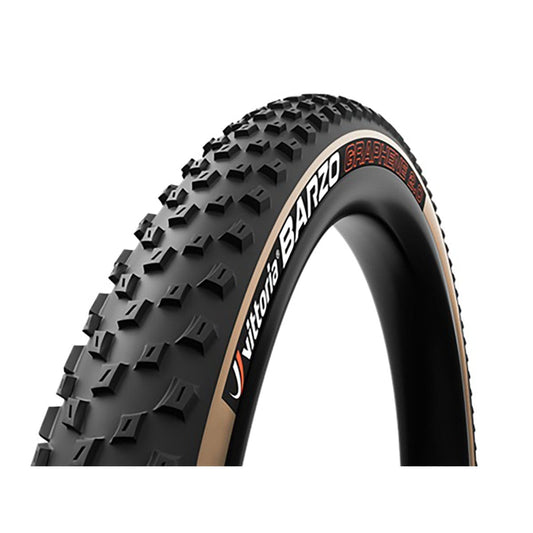
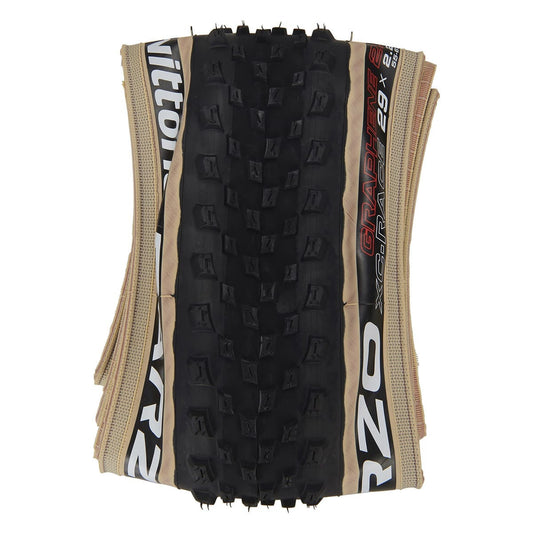
VITTORIA BARZO XC RACE 29x2.25 4C Graphene 2.0 tire Tubeless Ready Soft Black/Beige
Regular price 39,99 €Regular priceUnit price per -
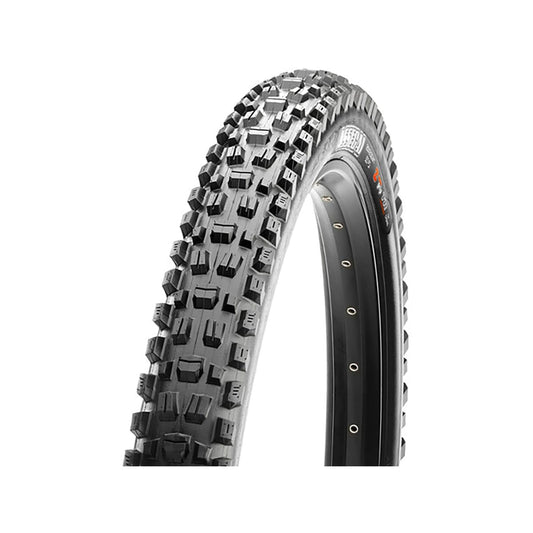
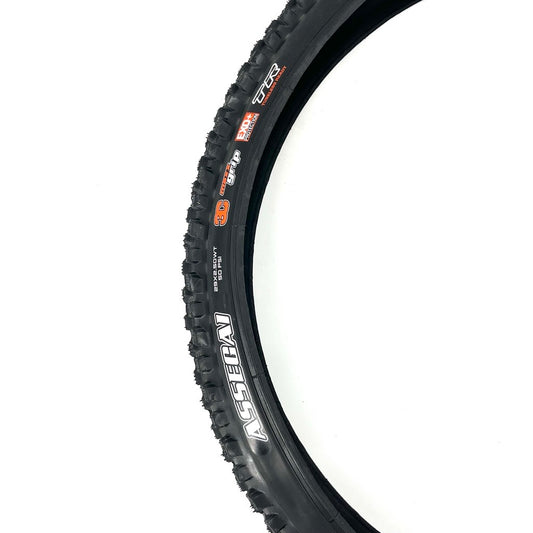
MAXXIS ASSEGAI 29x2.50 WT Exo+ 3C tire MaxxGrip Tubeless Ready Soft Black
Regular price 54,99 €Regular priceUnit price per -
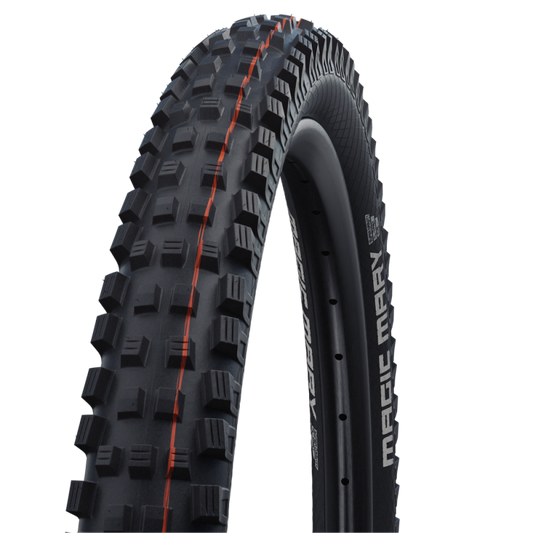
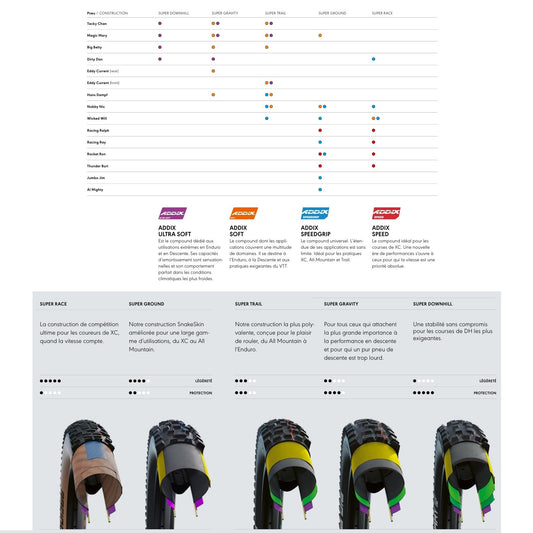
SCHWALBE MAGIC MARY 29x2.60 ADDIX SOFT SUPERTRAIL Tubeless Ready Soft Black tire
Regular price 49,99 €Regular priceUnit price per -
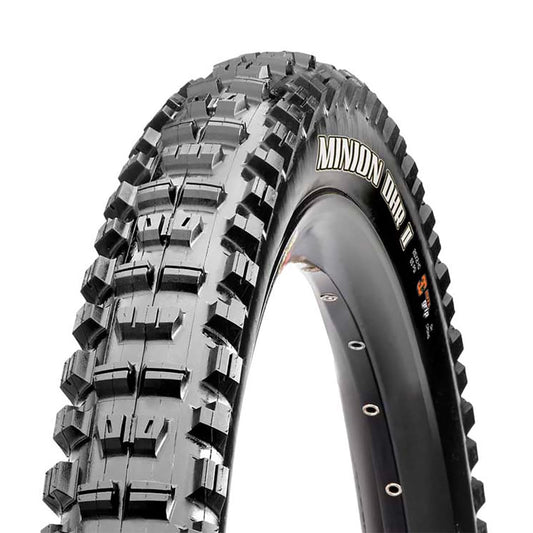
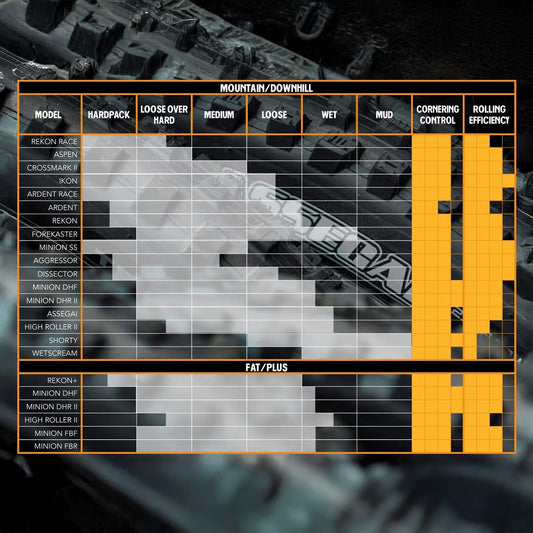
MAXXIS MINION DHR II 29x2.30 Exo tire Tubeless Ready Soft Black
Regular price 39,99 €Regular priceUnit price per
